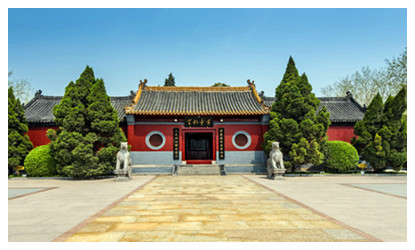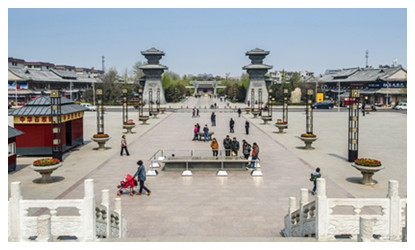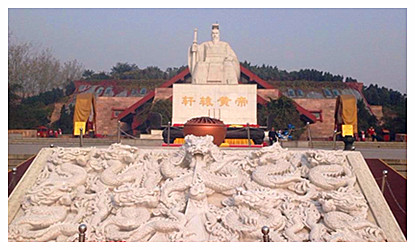Skype: neodalle-travel
Tel: +86 135 7447 2266
E-mail: sales@zhangjiajieholiday.com
Covering more than 17 acres, the Native Place of Emperor Huangdi is located in the north of Xinzheng City. As a scenic spot of AAA class assessed by the National Tour Bureau, it is a holly land for Chinese people all over the world to worship their ancestor, with memorial, temples, and mausoleums of Emperor Huangdi situated here.
What to see ?
 The Embossment Plate of the Universe
The Embossment Plate of the Universe
The Embossment Plate of the Universe is a sculpture integrated with six typical Chinese cultural masterpieces, namely the solarium, an ancient observing device of astronomical phenomena; taiji map, an abstracted philosophical painting for study of the nature and the society; four saint animals, an embodiment of the four directions; bagua map, an philosophical picture made of abstracted signals embodying parts of the universe; 12 animals of the years, an embodiment of the calendar and 28 stars, representatives of the astronomy.
The Xuanyuan (Emperor Huangdi) Bridge
The Xuanyuan Bridge above the Jishui River was a rebuilt arch bridge elegantly decorated with carved white marbles bearing double dragons, 10 meters in width and 12 meters in length with 3 parts.
The Chinese Pagoda Tree of Emperor Huangdi
The Chinese pagoda tree, also named “Guohuai” or “Huangdihuai”, a feature tree of Emperor Huangdi’s tribe with character of perseverance and straightness, is considered the embodiment of character of people of Xinzheng, Henan.
The No.1 Stele of China Excavated in 1996 from ancestral memorial remains of the Kingdom Han, 600 meters to the west of the Native Place of Emperor Huangdi, this stele for time-measuring and ancestor worshipping was the first of its kind dated back to the Eastern Zhou Dynasty. 3.26 meters in height, 0.45 meters in width and 0.26 meters in thickness, this stele is a proof of the Chinese tradition of worshipping the ancestor, nowprotected as a culture relic of the national class A, laurelled as the No.1 stele of China.
 Stele of Emperor Xuanyuan Huangdi
Stele of Emperor Xuanyuan Huangdi
Set up by the Chinese Yan-huang Academy, this stele recorded the brief introductions to the life of Emperor Huangdi and his inventions, his self-giving devotions and his historical contributions which has won the respect of the Chinese people.
The Memorial Temple of Emperor Xuanyuan Huangdi
The Memorial Temple of Emperor Xuanyuan Huangdi was established in the Han Dynasty and rebuilt in 1570 A.D. of the Ming Dynasty with the Xuanyuan Bridge built in front of the memorial temple. In 1715 of the Qing Dynasty, Xu Chaozhu, the governor of Xinzheng County, established a stele with inscription of “The Native Place of Emperor Xuanyuan Huangdi” here. In 2000, the memorial temple was approved as one of the key provincial reservations of cultural relics.
The Dingtan (Tripod Caldron Altar) Area
There are nine great tripod caldrons in Dingtan, standing at the nine positions of bagua, an ancient Chinese philosophical abstract. The Dingtan Square has floors made of bluestone boards embodying the vast sea and harmony of the nature and human beings. The base of the altar in shape of a square means in bagua the comprehensive mother earth with each side 50 meters long, embodying the Chinese civilization of 5,000 years. The top of the altar in shape of an octagon embodies the eight directions in bagua and the unity of each part of the nation. The round surface of the altar top embodies the sky in bagua and the endless development of Chinese civilization in the changing universe. The numbers of the height of the altar are implicative. The total height of the altar of 5 meters stands for the 5 elements forming the world in Chinese traditional culture and the five physiognomies of the lands, implying the standing position of the altar in China. The first section of the altar has 6 steps, referring to the 6 climates in bagua, implying the changing universe. The second and the third section of the altar have 9 steps respectively, referring to the majesty of the altar since 9 is the largest number leading to maximum in traditional Chinese culture.
Totem Poles of Nationalities
 Totem Poles of Nationalities, the stone columns with badges and introductions of the 56 nationalities of China standing besides the paved path leading to a main hall, remind visitors of the common cultural roots of all the Chinese and their universal ancestor of Emperor Huangdi.
Totem Poles of Nationalities, the stone columns with badges and introductions of the 56 nationalities of China standing besides the paved path leading to a main hall, remind visitors of the common cultural roots of all the Chinese and their universal ancestor of Emperor Huangdi.
The Bluestone Path to the Hall
The Bluestone Path to the Hall connects the Memorial Hall and the Dingtan Altar, with a length of 50 meters, representing the 5,000 years of Chinese civilization. The 2-meter wide central path made of bluestones has inscriptions of the important changes, affairs, heroes, mingling of nationalities and achievements of technology, education and culture of the Chinese people in a history of about ten thousands years.
The Saint Tripod Caldron of Emperor Huangdi
Thousands of years have passed by since Emperor Huangdi, the starter of Chinese civilization, left us. However, his spirit is always with us. The Saint Tripod Caldron of Emperor Huangdi was just built in honor of him, embodying the Chinese traditional culture.
The three legs of the tripod caldron are cast in the shape of bears, reminding of the Emperor Huangdi’s rising from the Youxiong (Bear) Tribe. The three-sided body of the tripod caldron has embossment of three dragons with a fireball, implying the glorious sun and praying for favorable weather for crops and a harvest. Standing at the center of the altar, it is laurelled as “the No.1 tripod caldron of the world” for its unparalleled size and its special origin. 6.99 meters in height, 24 tons in weight, with a diameter of 4.7 meters, it is 5.6 meters higher and 23.6 tons heavier than the Simuwu Square Caldron of the Shang Dynasty and 0.39 meters higher and 8 tons heavier than the bronze tripod caldron of Zaoqing of Guangdong province, which has been registered in the Guinness World Records. The height number of 6.99 made up of figure 6 and 9 implies the majesty of grandness in traditional Chinese culture. As to its special origin, it was made in Xinzheng, the place where Peiligang Ashes of a history of 8,000 – 9,000 years is located, the earliest origin of Chinese tripod caldrons. Tripod caldrons have always been considered saint vessels guarding the peace of the country by emperors of every dynasty. The Saint Tripod Caldron of Emperor Huangdi is round in shape, taking after the appearance of the tripod caldron excavated in the Peiligang Ashes dating back to 8,000 – 9,000 years ago.
There are also some other tripod caldrons standing respectively for the official posts, the wisdom, the harvest, the security, the offspring, the longevity and the fortune.
The Xuanyuan (Emperor Huangdi) Hill
The Xuanyuan Hill is the birth place of Emperor Huangdi. There is an interesting story about the birth of Emperor Huangdi. Legend has it that overlooking the human world from the heaven, the God, the Xuanyuan Huangdi, was full of sympathy with the poverty of people despite the beauty of the landscape. To help them, he turned himself into a yellow dragon and flew towards the human world. A girl was collecting fruits near the Xuanyuan Hill when all at once the sky was covered by rolling dark clouds with a yellow dragon circling the stars of the “Charles's Wain”. With the crack of a sudden thunder, the yellow dragon threw itself upon her. When she came round, it was sunny again and she found herself pregnant. 24 months later, she gave birth to a boy, the Xuanyuan Huangdi. Although the story may not be true, it shows people’s respect to him. In the Han Dynasty, a memorial temple was established in honor of Emperor Huangdi’s achievements and merits. In the Qing Dynasty, Xu Chaozhu, the governor of Xinzheng set up a stele with inscription of “The Native Place of Emperor Xuanyuan Huangdi”, making here a holy land for Chinese descendants to worship their ancestor.
Ancestor worshiping activities
Many Chinese descendants from all over the world, including those of Korea, Japan, Malaysia, Thailand, Vietnam, Singapore, the U.S., Taiwan and Hong Kong, come here every March 3rd of the lunar calendar to hold the Yan-huang Culture Festival, making it a holy land for Chinese to worship their ancestors. There is usually drumbeating, dragon dancing, fruits and flowers presenting and other ancestor worshiping activities. The ninth Yan-huang Culture Festival organized by the government took place in 2001. For its special historic and cultural value, the Native Place of Huangdi has become an important emotional bond connecting Chinese people both domestic and abroad to unite together.
 Ask Questions ?
Ask Questions ?